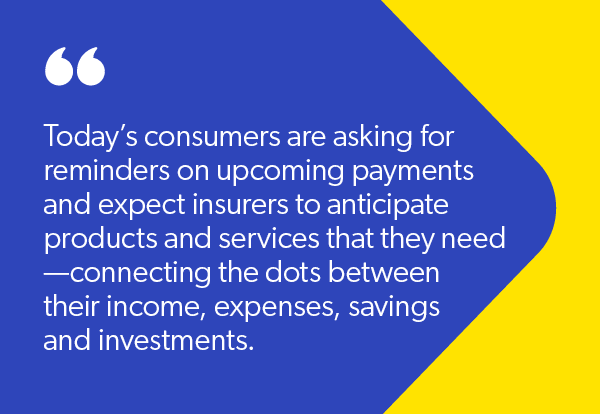Property and casualty insurers (P&C) are missing opportunities to expand share of wallet by not serving clients with personalized services—and the gap will grow as nontraditional insurance brokers serve customers relevant products.
In 2020, 27% of consumers said they were likely to consider buying insurance from online service providers, such as Amazon or Google, up from 22% just two years before. And 24% said they would consider buying it from a supermarket or retailer, up from 18% in 2018, Accenture found in its global Insurance Consumer Study.
Insurers are responding: 88% say that they expect digital channel use to grow in 2021, and 85% expect self-service to increase along with it.
But this is just table stakes.
Personalization in Insurance Still Missing
Insurers still have not delivered a seamless digital experience to their customers—let alone offered the highly personalized experiences that consumers are looking for.
There are two keys to providing such personalized offers: data and the ability to make sense of it. “Customer centricity will rise or fall based on the data, analytics, and application of AI to predict and seamlessly act on potential customer risks and needs,” according to Forrester in its 2021 report, Six Trends That Are Shaping P&C Digital Insurance Tech Strategies.
But some insurers have difficulty using data they already have to entice existing customers to buy more of their general product offerings. For example, a leading insurer with life insurance and protection, pensions and retirements, investments, and health insurance divisions found only 3% of its customers were present across all four divisions.
The remaining 97% represents a substantial opportunity to expand your share of wallet with relevant, personal offers across different product lines and services.

Finding Data Isn’t the Problem
To get digital offerings that are tailored to their specific needs, consumers are willing to give you access to more personal data than ever before.
What’s more, you have access to data from an almost-dizzying array of internal and external options—the most obvious of which is the customer data that you already have. Unfortunately, it’s often stuck in old or inactive databases that may be difficult to access.
Social media is also a rich source of data for insurers, said Duck Creek Technologies, adding that “its role in the insurance industry is evolving beyond marketing strategies and clever advertisements. Mining social media data is improving risk assessment for P&C insurers, bolstering fraud detection capabilities, and enabling entirely new customer experiences.”
Internet of Things (IoT) devices send usage and risk data—based on users’ behavior and habits—back to insurers, as do telematics such as driving monitors. Insurers are also using clever techniques such as drones to inspect houses and gather other data for claims.
These data sources “bolster other insurance technology with first-hand data, improving the accuracy of risk assessment, giving insureds more power to directly impact their policy pricing, and ensure the opportunity to improve accuracy and revenues,” Duck Creek Technologies said.
Making Sense of Rich Data Is Key
This can only be done with some help with the heavy lifting. Making sense of all of this data to create personalized experiences and pricing demands machine learning, said Cecile Desmarais, Coveo senior account executive.
To be clear, personalization isn’t about “a center column of responses with facets and filters on the left hand side and little recommendation widgets on the right,” Desmarais said. It certainly involves a great UI, but it’s about a combination that creates an entire experience.
“Today’s consumers are asking for reminders on upcoming payments and expect insurers to anticipate products and services that they need—connecting the dots between their income, expenses, savings and investments. And, they want proactive guidance to help them reach their goals,” said Mike Connor, CEO of Silicon Valley Insurance Innovators.
But that need is tempered by trust issues. Almost half of consumers (49%) say they prefer speaking to a person when making insurance decisions, while only 12% say the same of automated service, and just 7% trust chatbots, Accenture said.
Building the trust we need to both leverage the data we have on consumers and provide them with personalized service that goes far beyond responding to questions will require building trust in AI. AI scientists and experts told IBM that doing so “will require a significant effort to instill in [AI] a sense of morality, operate in full transparency and provide education about the opportunities it will create for business and consumers.”
Machine learning, a subset of AI, provides some of this transparency natively. It uses models to operate—and that makes it predictable, understandable, and tunable. In other words, when implemented well, machine learning can overcome those trust obstacles and provide customers with personalized and repeatable experiences that build trust.
Omnichannel Personalization
If insurers are (still) struggling to complete digital transformation efforts and provide a full suite of services digitally, quickly implementing machine learning-driven data solutions will be a reach.
But for companies that are looking to improve the customer experience—not become or buy insurtech—off-the-shelf machine learning options are emerging.
These turnkey options let insurers focus on understanding their customers and use that knowledge to fine tune the machine.
Collecting behavioral signals across website activity—where did the site visitor go, what did they click on (and bounce from)—provides context for the machine to make personalized recommendations.

Reimagining Underwriting: Personalization and Prevention
According to McKinsey, underwriting will change to be more personalized—and more oriented to prevention rather than just risk mitigation. Imagine factoring in the data that comes from IoT and telematics.
You can use an aggregated score and compare it against other customers to see how risk is managed. Or use it to provide alerts to clients—or even rebates if people come in well below thresholds.
Customer churn has always been a problem in the industry, and according to HBR, getting new customers is five to 25 times more expensive than maintaining a client. How might your customer service change if you had 360-degree knowledge of their wants and needs?
Would you take extra steps before sending a cancellation notice for late payments if you could easily tell they had multiple policies that were still current?
Or would you automatically reduce payment as a reward for taking on a new policy?
Digital Is the New Normal
While insurers continue to struggle with becoming truly digital, the technology landscape is shifting around them—and offering more options to help them keep up with customer demand.
Making sense of and using data is central to the effort. Machine learning options that can be implemented quickly and easily and that improve over time will allow insurers to provide personalized policy options that suit both parties—insurers and insured.


